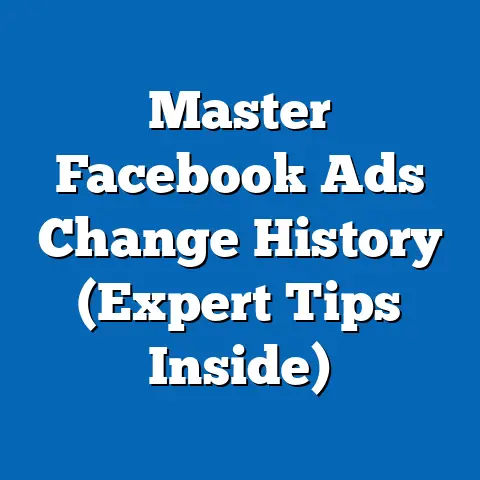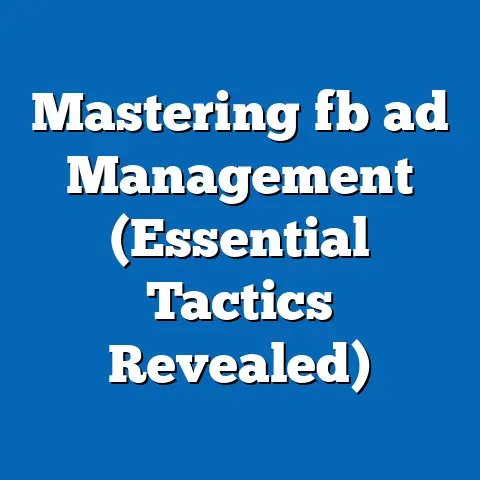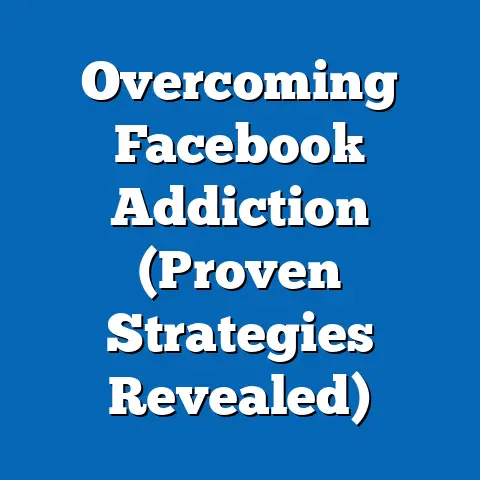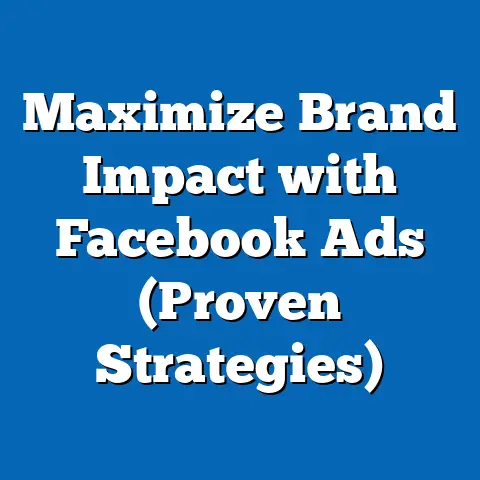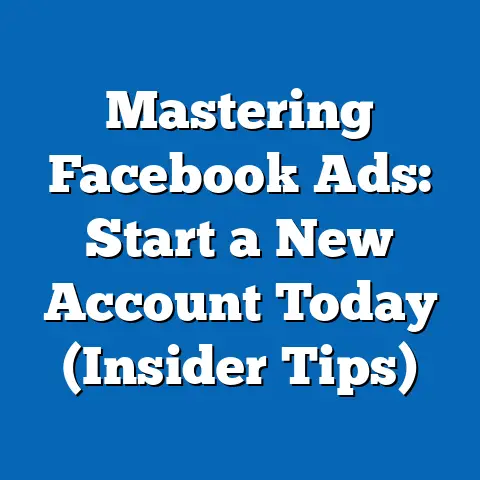Transform Facebook Ads Manager (Secrets to Boost ROI)
Have you ever felt like you’re throwing money into a black hole with your Facebook ads? I know I have. I remember vividly the frustration of launching campaign after campaign, only to see minimal returns and a dwindling budget. It felt like I was speaking a language no one understood, and my ads were just shouting into the void. I was running a campaign for my small e-commerce business, selling handcrafted jewelry. I poured hours into crafting what I thought were compelling ads, targeting what I believed was the perfect audience – women aged 25-45 interested in fashion and unique accessories. But the results were abysmal. Clicks were expensive, and conversions were virtually non-existent. I was on the verge of giving up on Facebook advertising altogether. That feeling of helplessness pushed me to dive deep into understanding the platform, analyzing data, and experimenting with different strategies. It was a long and arduous journey, filled with mistakes and setbacks, but it ultimately led me to discover the secrets to transforming my Facebook Ads Manager skills and achieving a significant boost in ROI.
This article isn’t just another generic guide on Facebook advertising. I’m going to share the specific strategies, tactics, and mindset shifts that completely changed my approach. I’ll walk you through the steps I took to understand the platform, set clear goals, target the right audience, create compelling ads, and continuously analyze and optimize my campaigns. By the end of this article, you’ll have the actionable knowledge you need to transform your own Facebook Ads Manager skills and unlock the true potential of this powerful advertising platform. Let’s get started!
Understanding Facebook Ads Manager
Facebook Ads Manager is the central hub for creating, managing, and analyzing your advertising campaigns on Facebook and Instagram. Think of it as your command center for reaching billions of potential customers worldwide. It’s a powerful tool, but like any complex system, it can be overwhelming at first.
The Ads Manager interface is packed with features, including options for:
- Audience Targeting: Defining who sees your ads based on demographics, interests, behaviors, and more.
- Ad Placements: Choosing where your ads appear, such as Facebook News Feed, Instagram Stories, or Audience Network.
- Budgeting: Setting your daily or lifetime ad spend and controlling how much you’re willing to pay for results.
- Reporting: Tracking key performance metrics like impressions, clicks, conversions, and ROI.
One of the biggest challenges I faced initially was navigating this complex interface. I spent countless hours clicking through different options, trying to understand what each setting meant and how it would impact my campaigns. It felt like I was lost in a maze with no clear path to success. But I quickly learned that mastering the basics of the Ads Manager is essential for effective advertising. Understanding how each feature works and how they interact with each other is crucial for making informed decisions and optimizing your campaigns for maximum ROI.
Takeaway: Familiarize yourself with the Facebook Ads Manager interface. Explore the different sections, experiment with the settings, and don’t be afraid to make mistakes. The more you use the platform, the more comfortable you’ll become with its features and functionalities.
Setting Clear Goals
Before you even think about creating your first ad, it’s crucial to define your goals. What do you want to achieve with your Facebook advertising campaigns? Are you trying to increase brand awareness, generate leads, drive sales, or something else entirely?
Setting clear goals is not just about having a general idea of what you want to achieve. It’s about defining specific, measurable, achievable, relevant, and time-bound (SMART) goals.
Here’s an example of a SMART goal:
- Specific: Increase website traffic.
- Measurable: Increase website traffic by 20%.
- Achievable: Based on previous campaign performance and market trends.
- Relevant: Aligns with overall business objectives of increasing online sales.
- Time-bound: Within the next three months.
When I started setting SMART goals for my campaigns, I noticed a dramatic shift in my approach. Instead of blindly throwing money at ads, I was now focused on achieving specific, measurable outcomes. This clarity helped me make better decisions about targeting, ad creatives, and budgeting.
Here are a few examples of different types of goals and how they influence your ad strategy:
- Brand Awareness: Focus on reaching a broad audience with visually appealing ads that showcase your brand’s personality and values.
- Lead Generation: Target a specific audience with ads that offer valuable content in exchange for their contact information.
- Sales Conversion: Retarget website visitors or customers with ads that promote specific products or services and offer incentives to purchase.
Takeaway: Define SMART goals for your Facebook advertising campaigns before you start creating ads. This will help you stay focused, make better decisions, and measure your results more effectively.
Audience Targeting Strategies
One of the most powerful features of Facebook Ads Manager is its ability to target specific audiences based on a wide range of factors, including demographics, interests, behaviors, and more. This level of precision allows you to reach the people who are most likely to be interested in your products or services.
There are three main types of audiences you can target on Facebook:
- Core Audiences: These are audiences based on demographics, interests, and behaviors. You can target people based on their age, gender, location, education, job title, interests, hobbies, and more.
- Custom Audiences: These are audiences based on your own data, such as email lists, website visitors, or app users. You can upload your customer lists to Facebook and target them with personalized ads.
- Lookalike Audiences: These are audiences based on the characteristics of your existing customers. You can create a lookalike audience based on your email list, website visitors, or Facebook page fans.
Creating custom and lookalike audiences can significantly enhance your ad performance. For example, if you have a list of your best customers, you can upload it to Facebook and create a lookalike audience based on their characteristics. This will allow you to reach new potential customers who are similar to your existing ones.
I remember one campaign where I was struggling to reach the right audience. I was targeting a broad audience based on general interests, but the results were disappointing. Then, I decided to create a custom audience based on my website visitors and a lookalike audience based on my email list. The results were incredible. My click-through rate (CTR) increased by 50%, and my conversion rate doubled.
Takeaway: Don’t rely solely on broad targeting options. Take the time to understand your target audience and leverage Facebook’s custom and lookalike audience features to reach the people who are most likely to be interested in your products or services.
Crafting Compelling Ad Creatives
Even with the best targeting strategies, your ads won’t be effective if they don’t grab attention and resonate with your audience. That’s why crafting compelling ad creatives is essential for success.
Effective ad creatives typically include the following elements:
- Visuals: High-quality images or videos that capture attention and convey your message.
- Copy: Clear, concise, and persuasive text that highlights the benefits of your product or service.
- Call to Action (CTA): A clear and compelling instruction that tells people what you want them to do (e.g., “Shop Now,” “Learn More,” “Sign Up”).
One of the biggest mistakes I see marketers make is using generic or uninspired ad creatives. Your ads need to stand out from the crowd and capture people’s attention within seconds.
A/B testing different ad formats and messages is crucial for finding what resonates best with your audience. Experiment with different visuals, headlines, body copy, and CTAs to see what performs best.
For example, you could test two different images for the same ad: one featuring a product shot and another featuring a lifestyle shot. Or, you could test two different headlines: one that focuses on the benefits of your product and another that focuses on the features.
I’ve found that small changes to my ad creatives can have a significant impact on performance. For example, simply changing the color of my CTA button from blue to green increased my CTR by 15%.
Takeaway: Invest time and effort in crafting compelling ad creatives that capture attention and resonate with your audience. A/B test different ad formats and messages to find what performs best.
Analyzing and Optimizing Campaigns
Facebook Ads Manager provides a wealth of data that you can use to analyze and optimize your campaigns. By monitoring key performance metrics and making adjustments based on data insights, you can significantly improve your ROI.
Key performance metrics to monitor include:
- Impressions: The number of times your ad was shown.
- Reach: The number of unique people who saw your ad.
- Click-Through Rate (CTR): The percentage of people who clicked on your ad after seeing it.
- Cost Per Click (CPC): The average cost you paid for each click on your ad.
- Conversion Rate: The percentage of people who completed a desired action (e.g., purchase, sign-up) after clicking on your ad.
- Return on Ad Spend (ROAS): The amount of revenue you generated for every dollar you spent on advertising.
I remember one campaign where my CPC was unusually high. I analyzed the data and discovered that my ads were being shown to a broad audience that wasn’t particularly interested in my product. I narrowed my targeting and improved my ad creatives, and my CPC dropped by 50%.
Takeaway: Don’t just set up your campaigns and forget about them. Continuously monitor key performance metrics and make adjustments based on data insights. This will help you optimize your campaigns for maximum ROI.
Conclusion
Transforming your Facebook Ads Manager skills and boosting your ROI is not an overnight process. It requires dedication, strategic planning, and a willingness to learn and adapt. But the rewards are well worth the effort.
By understanding the platform, setting clear goals, targeting the right audience, crafting compelling ads, and continuously analyzing and optimizing your campaigns, you can unlock the true potential of Facebook advertising and achieve significant results for your business.
My personal journey from struggling with Facebook ads to achieving consistent ROI is a testament to the power of these strategies. I started with a feeling of frustration and helplessness, but through dedication and a willingness to learn, I was able to transform my approach and achieve success.
I encourage you to apply the secrets I’ve shared in this article to your own campaigns and witness your own success stories. Remember, the key to success is to stay focused, be persistent, and never stop learning. Good luck!


